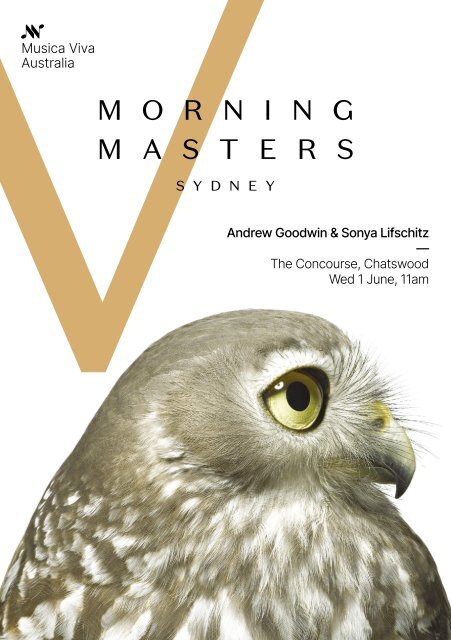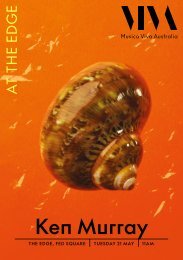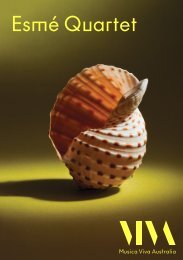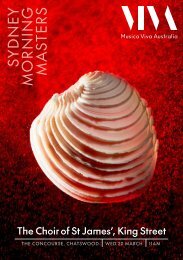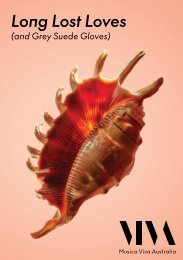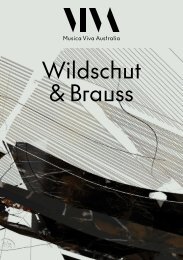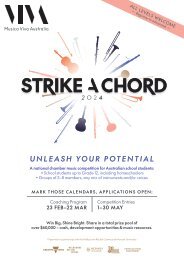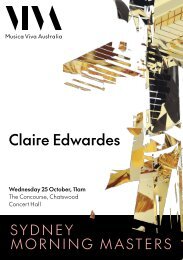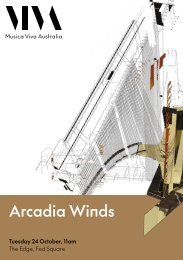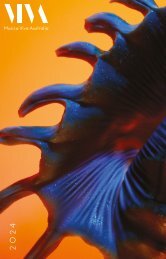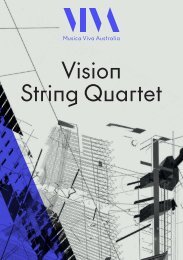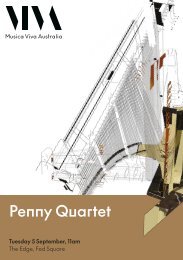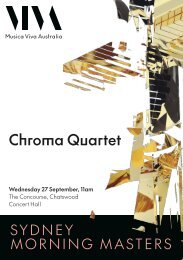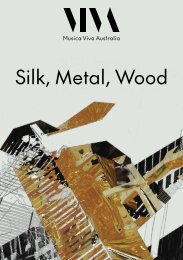Goodwin Lifschitz Program Guide | June 2022
Create successful ePaper yourself
Turn your PDF publications into a flip-book with our unique Google optimized e-Paper software.
M O R N I N G<br />
M A S T E R S<br />
S Y D N E Y<br />
Andrew <strong>Goodwin</strong> & Sonya <strong>Lifschitz</strong><br />
—<br />
The Concourse, Chatswood<br />
Wed 1 <strong>June</strong>, 11am
M O R N I N G<br />
M A S T E R S<br />
S Y D N E Y<br />
Wed 13 Jul, 11am<br />
Harry Bennetts & Vatche Jambazian<br />
—<br />
Wed 7 Sep, 11am<br />
Goldner String Quartet<br />
—<br />
Wed 26 Oct, 11am<br />
Vocal Detour<br />
The Concourse, Chatswood<br />
—<br />
Tickets now available – from $48<br />
musicaviva.com.au/sydney-morning-masters<br />
1800 688 482
Musica Viva Australia acknowledges the Traditional Custodians of the Cammeraygal<br />
people and we pay our respects to their Elders past and present – people who have<br />
sung their songs, danced their dances and told their stories on these lands<br />
for thousands of generations, and who continue to do so.<br />
PROGRAM<br />
Gabriel FAURÉ (1845-1924)<br />
‘Après un rêve’ from Trois mélodies, Op. 7 (1870-78)<br />
Au bord de l’eau, Op. 8 No. 1 (1871)<br />
Reynaldo HAHN (1874-1947)<br />
À Chloris (1913)<br />
Francis POULENC (1899-1963)<br />
‘Fleurs’ from Françailles pour rire, FP101 (1939)<br />
‘Paganini’ from Métamorphoses, FP121 (1943)<br />
Johannes BRAHMS (1833-1897)<br />
Intermezzo in E-flat Minor, Op. 118 No. 6 (1893)<br />
Robert SCHUMANN (1810-1856)<br />
Myrthen, Op. 25 (1840)<br />
Die Lotosblume<br />
Widmung<br />
Richard STRAUSS (1864-1949)<br />
Morgen!, Op. 27 No. 4 (1894)<br />
Zueignung, Op. 10 (1885)<br />
Gustav MAHLER (1860-1911)<br />
‘Wo die schönen Trompeten blasen’<br />
from Des Knaben Wunderhorn, No. 7 (1898)<br />
Alexander SCRIABIN (1871-1915)<br />
Nocturne for the Left Hand, Op. 9 No. 2 (1894)<br />
Sergei RACHMANINOFF (1873-1943)<br />
Lilacs, Op. 21 No. 5 (1900-02)<br />
Yesterday We Met, Op. 26 No. 13 (1906)<br />
Spring Waters, Op. 14 No. 11 (1894-96)<br />
3 min<br />
2 min<br />
4 min<br />
3 min<br />
1 min<br />
5 min<br />
2 min<br />
2 min<br />
4 min<br />
2 min<br />
8 min<br />
6 min<br />
5 min<br />
3 min<br />
2 min<br />
|<br />
3<br />
|<br />
Andrew <strong>Goodwin</strong> Tenor<br />
Sonya <strong>Lifschitz</strong> Piano
MEET THE ARTISTS<br />
|<br />
4<br />
|<br />
Andrew <strong>Goodwin</strong><br />
Andrew <strong>Goodwin</strong> has appeared with opera<br />
companies and orchestras in Europe, Asia<br />
and Australia including the Bolshoi Opera,<br />
Gran Theatre Liceu Barcelona, Teatro Real<br />
Madrid, La Scala Milan, Opera Australia,<br />
Pinchgut Opera, Sydney Chamber Opera,<br />
St Petersburg Philharmonic, Auckland<br />
Philharmonia, New Zealand, Sydney,<br />
Melbourne, Queensland, Adelaide and<br />
Tasmanian Symphony Orchestras,<br />
Moscow and Melbourne Chamber<br />
Orchestras, Sydney Philharmonia Choirs,<br />
and in recital with pianist Daniel de Borah<br />
at Wigmore Hall, the Oxford Lieder, Port<br />
Fairy and Canberra International Music<br />
Festivals.<br />
In addition to his recital for Musica Viva<br />
Australia, this year Andrew has been<br />
engaged to return to the Melbourne Bach<br />
Choir (Evangelist in Bach’s St Matthew<br />
Passion, and Haydn’s Die Schöpfung),<br />
Canberra International Music Festival<br />
and Australian Haydn Ensemble (Haydn’s<br />
Creation), Queensland Symphony<br />
Orchestra (Messiah and Mozart’s<br />
Requiem), Canberra and Melbourne<br />
Symphony Orchestras (Messiah), Albury<br />
Chamber Music Festival, Sanguine Estate<br />
Music Festival and Hayllar Music Tours.<br />
Andrew is a founding member of Katie<br />
Noonan’s new vocal ensemble, AVÉ and<br />
will also tour with the ensemble this year.<br />
Recent engagements include Lysander,<br />
A Midsummer Night’s Dream (Adelaide<br />
Festival); Jacquino, Fidelio (West Australian<br />
Symphony Orchestra); Nadir, The<br />
Pearlfishers (State Opera South Australia);<br />
The Diary of One Who Disappeared and<br />
The Rape of Lucretia (Sydney Chamber<br />
Opera); Artaxerxes title role (Pinchgut<br />
Opera); Berlioz‘ L’Enfance du Christ and<br />
Mozart’s Requiem (MSO); Brett Dean’s<br />
The Last Days of Socrates and Mozart’s<br />
Litaniae de venerabili altaris sacramento<br />
(SSO); Messiah (Sydney Chamber Choir,<br />
NZSO, QSO and MSO); Bach’s Magnificat<br />
and The Rake’s Progress title role<br />
(Auckland Philharmonia Orchestra); and<br />
performances at Adam Chamber Music<br />
Festival New Zealand, Huntington Estate<br />
Music Festival, and Australian Festival of<br />
Chamber Music.
Sonya <strong>Lifschitz</strong><br />
Sonya <strong>Lifschitz</strong> is a pianist working across<br />
many contexts, with repertoire spanning<br />
from the 15th-century Faenza Codex to<br />
works written especially for her. She is<br />
known for her fiercely imaginative, daring<br />
collaborations across theatre, dance,<br />
screen-based and visual arts, spoken<br />
word, and performance art. Described<br />
as ‘a life force of extraordinary density<br />
and capacity’, Sonya’s artistry combines<br />
bold adventurousness with ‘miraculous<br />
keyboard technique and musicianship’<br />
(Woodstock Times) to create work that<br />
positions classical and contemporary<br />
art music at the cutting edge of<br />
interdisciplinary performance practices.<br />
She is active as a soloist, creative<br />
collaborator, artistic director, educator,<br />
radio personality and arts advocate.<br />
Sonya has performed on major<br />
international stages to critical acclaim<br />
including the Barbican Centre (London),<br />
De Doelen (Rotterdam), Bargemusic (New<br />
York), Detroit Institute of Art (USA), Venice<br />
Biennale (Italy), and in many of Australia’s<br />
major international arts festivals, including<br />
Adelaide, Sydney, Melbourne, Brisbane,<br />
Canberra and Darwin festivals; and other<br />
prestigious festivals including Extended<br />
Play, Metropolis, MONAFOMA, Four Winds<br />
and Ten Days on the Island.<br />
Sonya regularly works with pioneering new<br />
music ensembles, including Ensemble<br />
Offspring, Topology, Clocked Out, and<br />
members from Bang On A Can All-Stars<br />
(USA) and Eighth Blackbird (USA). She<br />
has premiered works by Kate Neal, Robert<br />
Davidson, Damian Barbeler, Andrew<br />
Schultz, Jessica Wells, Felicity Wilcox,<br />
Anthony Lyons, Larry Sitsky, Bree van Reyk,<br />
Max Lyandvert and Steve Adam. Other<br />
significant collaborators include Christine<br />
Johnston (performance art), Sydney Dance<br />
Company, Martin del Amo (dance), Angelica<br />
Mesiti (video art), Sal Cooper (video/<br />
animation), Bob Scott (sound design),<br />
and pianists Stephen Emmerson and Lisa<br />
Moore.<br />
Sonya has been featured on ABC and<br />
SBS TV and on national radio, including<br />
ABC Classic’s Legends, Duet, Festival of<br />
Female Composers, New Waves and ABC<br />
Radio National’s Music Show. As a Fulbright<br />
Scholar Sonya studied with the legendary<br />
American pianist Leon Fleisher and<br />
currently heads Music Performance and<br />
Creative Practice streams at the School of<br />
Arts and Media at the University of NSW.<br />
|<br />
5<br />
|<br />
Musica Viva Australia: Making Australia a more musical place<br />
At Musica Viva Australia, we’re proud to be<br />
one of the world’s leading presenters of<br />
chamber music. Passionate about creating<br />
a vibrant musical future for Australia’s artists<br />
and audiences, we feel fortunate to nurture<br />
both established and emerging talent from<br />
around the country. We’re also committed<br />
to learning from our First Nations friends<br />
and colleagues how to most effectively<br />
include in our work the many peoples and<br />
languages that, together, comprise the<br />
oldest living culture in the world.<br />
Musica Viva Australia is committed to the<br />
future of classical music, and to being at<br />
the forefront of its evolution. Our dedication<br />
to the commissioning and programming<br />
of new Australian works is key to our<br />
vision, and through eclectic and thoughtful<br />
programming, we endeavour to lead<br />
the industry in presenting concerts that<br />
challenge and thrill all audiences.
ABOUT THE MUSIC<br />
|<br />
6<br />
|<br />
Like all good poetry, the very best<br />
artsongs explore the universal desires and<br />
sufferings of the human heart.<br />
Après un rêve, ‘After a dream’, one of<br />
Gabriel Fauré’s most popular vocal works,<br />
captures an extraordinarily melancholy<br />
mood within its mere 48 bars. The poem<br />
describes a passionate encounter within<br />
a dream to which the dreamer longs to<br />
return, despite its falsity. ‘I dreamed of<br />
happiness, that burning mirage’....<br />
Au bord de l’eau is a more hopeful<br />
reflection on love. All earthly beauties of<br />
the world are described with apathy, paling<br />
in comparison to the deep passion felt<br />
by two lovers as they sit on the bank of a<br />
flowing stream. This sentiment is reflected<br />
as well in Reynaldo Hahn’s À Chloris, an<br />
exquisite declaration of timeless love,<br />
announced in the Baroque-like piano<br />
introduction.<br />
Francis Poulenc reflects on the traditional<br />
demonstration of love in Fleurs, but it<br />
is within Paganini that we gain deeper<br />
insight into the composer’s soul. He was<br />
largely self-taught as a composer, due to<br />
family opposition to his chosen career. No<br />
wonder he held the famously independent<br />
violinist in such reverence, paying tribute<br />
to the violin in this work as ‘seahorse and<br />
siren’, the ‘pride of delicate hands’, and<br />
‘alcohol of the troubled soul.’<br />
Johannes Brahms moved in with Robert<br />
and Clara Schumann for several months<br />
at the age of 20. History acknowledges<br />
Robert’s influence in composition and<br />
musicology on his young protégé, and likes<br />
to dwell on Brahms’ lifelong attachment to<br />
Clara. Often overlooked is that Clara was<br />
considered perhaps the greatest pianist<br />
of that golden era, admired by Chopin,<br />
Liszt and Mendelssohn, and her effect on<br />
Brahms’ own pianism cannot have been<br />
negligible. The Op. 118 set is dedicated to<br />
her, its balance of beauty and technique an<br />
understated tribute to her powers.<br />
Robert Schumann’s courtship with<br />
Clara before their marriage had been<br />
complicated. Clara’s father opposed<br />
their engagement to the bitter end. Die<br />
Lotosblume is thought to be an analogy<br />
for the three of them: the lotus flower, the<br />
sun and the moon might represent Clara,<br />
her father and Robert respectively – and<br />
of course, the lotus flower only blooms<br />
at night! Robert’s joy at their eventual<br />
marriage is palpable in the virtuosic<br />
Widmung, dedicated to Clara as a wedding<br />
gift.<br />
Morgen! was also a wedding present,<br />
from Richard Strauss to his soprano<br />
wife Pauline. Pauline Strauss, protective<br />
wife of a famous husband, occasionally<br />
drew criticism for being eccentric and<br />
ill-tempered, but their marriage was by all<br />
accounts a happy one and she was a great<br />
inspiration for Richard’s musical output.<br />
The mighty Zueignung, ‘Dedication’, was<br />
composed before they met, but is an apt<br />
depiction of their devotion to one another.<br />
Strauss’s good friend Gustav Mahler was<br />
famously preoccupied with death, so it<br />
is perhaps no surprise that his depiction<br />
of love in Wo die schönen Trompeten<br />
blasen describes a girl visited by her<br />
lover not by the water, nor amongst<br />
flowers, but on the eve of a battle. The<br />
conflicting emotions are shown in the<br />
music, oscillating between a rigid marchlike<br />
feel of the opening and a more tender,<br />
dreamy waltz-like theme. The reality of his<br />
description of his beautiful home is thrown<br />
into devastating doubt at the mention of its<br />
green grass, implying he is already in the<br />
grave.<br />
One-handed piano works are not terribly<br />
common, but Alexander Scriabin’s<br />
Prelude and Nocturne for Piano, left hand,<br />
Op. 9 was written out of necessity. In the<br />
summer of 1891, Scriabin injured his right<br />
hand by over-practising virtuosic piano<br />
etudes. Still troubled by the injury three
A WINTER’S<br />
JOURNEY<br />
ALLAN CLAYTON & KATE GOLLA<br />
—<br />
Fresh from triumphant seasons as Hamlet (The Met) and Peter Grimes (Covent Garden),<br />
tenor Allan Clayton joins pianist Kate Golla for Schubert’s immortal songs of love and loss.<br />
Director Lindy Hume and video designer David Bergman weave a magical<br />
Australian setting from Fred Williams’ wondrous landscapes.<br />
—<br />
National Tour: 12–27 July | Barbican, London: 7 December<br />
musicaviva.com.au/a-winters-journey | 1800 688 482 | barbican.org.uk/whats-on<br />
This tour is generously supported by Peter Griffin AM & Terry Swann, and Suzie Dickson.<br />
Copyright Gary Heery<br />
years later, Scriabin wrote this work and<br />
was delighted at its popularity in America<br />
when he travelled to New York in 1906.<br />
Depictions of flowers as a metaphor for<br />
love return once again in Lilacs. Lilacs<br />
quickly became immensely popular,<br />
perhaps due in part to its radiant contrast<br />
to Sergei Rachmaninoff’s melancholy<br />
vocal music of the 1890s. The piece<br />
became so popular in fact that, beginning<br />
in 1908, Rachmaninoff received a bouquet<br />
of lilacs at every concert he performed<br />
in, everywhere in the world until 1918.<br />
His anonymous admirer was eventually<br />
revealed to be Madame Felka Rousseau,<br />
whose only wish was that he return to<br />
perform in Russia. Rachmaninoff had fled<br />
his country in 1917 following the Russian<br />
Revolution, and after explaining that it was<br />
unlikely that he would be able to return at<br />
all due to the political situation, the lilac<br />
bouquets promptly stopped appearing.<br />
Images of nature are also found in his<br />
Spring Waters, whose thaw heralds the<br />
change of the seasons, rejoicing in the end<br />
of winter. Yesterday We Met is a haunting<br />
description of a chance encounter with an<br />
old flame.<br />
© <strong>2022</strong> JAMES MOUNTAIN / K P KEMP


